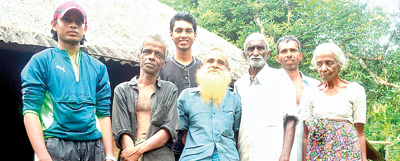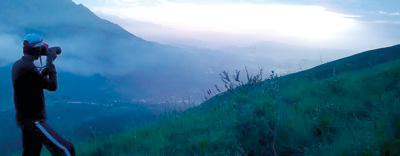Living our dream in the wilds
View(s):When my explorer buddy Minol Peiris and I finished our A’Ls, we could not wait to kick start our life as campers. Surfing the net, we came across the Lakdasun Forum(www.lakdasun.org) and a trip report to a mountain called Havagala. The pictures were so stunning, we felt we just had to see it ourselves.

Chryshane and Minol with the villagers who befriended them
So after much preparation we fixed the second weekend of January 2014 for the expedition. The book Collins’ Camping and Hiking Manual was a great help to us.
Havagala Mountain (1400m) or Hagala as it is known by the locals is located in beautiful Belihuloya in the Sabaragamuwa Province bordering the Horton Plains National Park. The vegetation is a mixture of montane forest and manna grasslands with scattered pine trees. The trail starts from the village of Laduyaya. To reach here one must travel to Belihuloya on the A4 main road and turn next to the Belihuloya Rest House; Laduyaya is 2 km up this road passing through the village of Ihalagalagama.
One could take the Colombo – Badulla bus and get off at Belihuloya (there is no town called Belihuloya, the nearest town is Galagama). The bus drops you right in front of the Belihuloya Rest House. Then you can take a trishaw or the Balangoda – Laduyaya bus and get off at the last stop at Laduyaya.
 Another interesting route will be to catch the Colombo – Badulla train, get off at Haputale and then take a bus back to Belihuloya. The villagers are friendly and will show the way up the mountain; they even will lead you to the summit. The nearest Police Station is Samanalawawe Police station; we had decided to inform them about the climb in case the unexpected happened. So with everything in place our adventure began.
Another interesting route will be to catch the Colombo – Badulla train, get off at Haputale and then take a bus back to Belihuloya. The villagers are friendly and will show the way up the mountain; they even will lead you to the summit. The nearest Police Station is Samanalawawe Police station; we had decided to inform them about the climb in case the unexpected happened. So with everything in place our adventure began.
We got into the Colombo – Badulla bus at 12.15 a.m. on Saturday hoping to reach Belihuloya by at least 5:30 a.m. We alighted in front of the Rest house at 4.30 a.m. By the side of the Rest house there was a road leading up which said Ihalagalagama. We tapped on the gate of the Rest house and the watcher told us the nearest town Galagama was just two bends away.
When we reached the town there was one shop open. We were told to proceed to Ihalagalagama. The hike up there was just amazing, the darkness disappearing to reveal the hills topped with the morning mist. Half way through we hopped onto a bus. The Police station is next to the Sabaragamuwa University which is 100m down the Samanalawawe road from Pambahinna junction. At 6.10 we reached the Police station; they were rather surprised that we informed them we were climbing the mountain!
On the way to the junction we had our morning snack from a market and caught a ride back to Galagama in a truck with a friendly local. It was now around 6:40 a.m. so we visited the beautiful St. Mary’s Church Galagama, had a chat with the parish priest there and headed to the temple where we had to catch the bus.
The ride through Ihalagalagama was captivating and we had a clear view of our destination. We inquired as to what time the bus leaves the village the next day and were told it leaves at 7:50, 10:35 and then again at 2 p.m. , so we planned to catch the 10:35 on our return.
At the last stop the driver showed us the path between some houses. Armed with two strong sticks we set off. There are two streams to cross to enter the mountain and there we met a wood cutter who led us through a path to the tea estate; we continued along the path but all of a sudden it stopped. Luckily we met the wood cutter again who directed us through the forest which was 30m directly in front of where the path ended.
The path was through the forest; we were entering leech country. We had to cross a slippery stream and creep through some thick undergrowth to reach the open; the Manna patches. So far the journey had been thrilling; trekking alone amidst nature is just simply exhilarating.This was the most exhausting part of the climb. From here one must go southwards while ascending. The slope became steep and there were many dangerously slippery streams to cross. When we sat down for a snack, I touched my back and my hand was full of blood; I immediately took off my T- shirt as I knew what it was, a blood sucking leech.
From here one could see the entire valley below and Horton Plains on the other side. The view was breathtaking. This manna patch was extremely difficult especially with heavy baggage. At one point it seemed an endless climb; many a time we thought that the summit was just over the slope but instead it was another steep climb.
We had planned to reach the summit by around 1 p.m. and have our lunch there; but it was already time up and we hadn’t reached the summit yet, so we sat down and had our lunch of fried meat and bread. A tip about food; Dates and Glucose are two essentials for quick energy when going on long-distant hikes.
By now, from the direction of Horton Plains rain clouds were rushing in. We could not afford to get wet we knew.
So now to our great disappointment we decided to make camp at an altitude of about 1200m; Minol found a flat area just behind a small pine tree, ideal to set up the tent so that it could rest against the tree in case of high winds. By the time we set the tent it was around 2.30 p.m. and the clouds were setting in; just then two wood cutters came up and when we asked how far the summit was, they said it was only about 500m away!
Now the priority was to find a water source as our bottles were almost empty. About 50m away we found a tiny stream close to the edge of the forest, the water was clean and cool. After a change we lit a camp fire and had a refreshing hot drink. Even though we could not make it to the summit, this was still superb, the cold weather, the magnificent view of Horton Plains, camping in the wild; We felt we were in paradise, living our dream.
Just as we finished our drink around 3.30 p.m, it began to rain and to our horror, the tent began leaking! Somehow we managed to keep the centre a bit dry and cramped in the middle we fell asleep. When we woke up at 4.30 p.m. the rain had stopped and it was getting dark and very cold. We set about building the fire again. The night sky was clear and with the moon light we did not really need the head lamps. We dozed off at 8.30 p.m. after having some canned baked beans for dinner.
We both woke up by 5 a.m. shivering and rushed out to get the fire started. The beauty of the scene before us, the mist from Horton Plains and the valley below lit up with the rays of the rising sun cannot be explained in words. We wanted to do this when we reached the summit but nevertheless we took out the Sri Lankan flag and our College flag and waved them for what seemed to be the climax of our great adventure.
After taking some amazing photographs we had some bread and beef for breakfast, filled our bottles with water, and broke camp at 7 a.m.. We took the same route we came up on or so we thought. We crossed those risky streams again but while on the Manna patch we noticed that there were far too many pine trees and realised we had taken a slight detour.
We began to make some steep descents till we reached the forest line but alas, it was impenetrable. The time was around 9 a.m. and now we faced the bitter truth, we came looking for adventure so here it was. We were lost! Luckily we had the police station number. We moved about till we had a signal on our phones and rang the police but they were of no help. “Find your own way,” the policeman we spoke to said. So now we were left with only one option: shout for help.
That was of no avail either. So we decided to go across the slope towards the south. With the adrenaline rushing through our bodies we were taking great risks – climbing, crawling, jumping, pulling and throwing our bags at times through the bushy slope not caring about the leeches. Then we came to the most dangerous part, we had to cross a 70 degree slope with water running down on flat rock. The only way across were a few grass patches here and there. The rock face was so slippery that one misstep would put one in a very ugly situation. As we were crossing it we heard people calling from the valley below.
We faintly heard them say there is a path down, so after crossing the ‘slope of death’ we rested a bit and began the steep descent. Heading through the forest, we met a villager named Gunepala who had given us directions earlier. He had been on his way to find us. He invited us for tea and we came to his small clay house where four smiling faces greeted us.
We immediately did a body check for leeches but to our amazement found none. They gave us plain tea and bananas and we shared our food. The memory of how these people welcomed and treated total strangers like us will stay with us.
To our surprise we still had time to make it to the bus at 10:35 a.m. so they helped us to carry the bags and took us to the location but we had just missed the bus. Many people came out to see us; it seems the entire village knew of our adventure. And so on our wild adventure we not only experienced the beauty of nature but also the beauty of man. At 2.05 p.m. the bus came and we said our goodbyes. At 3.10 we reached Balangoda and took a Colombo bound bus from there.
(The writer is a past student of St. Joseph’s College Colombo 10, of the 2013 A/L batch.)


